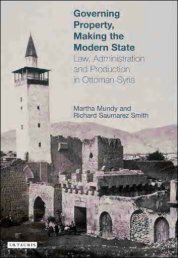The Invention of Tradition as Public Image in the Late ... - PSI424
The Invention of Tradition as Public Image in the Late ... - PSI424
The Invention of Tradition as Public Image in the Late ... - PSI424
You also want an ePaper? Increase the reach of your titles
YUMPU automatically turns print PDFs into web optimized ePapers that Google loves.
INVENTING TRADITION AS PUBLIC IMAGE 7<br />
described.17 In a detailed memorandum <strong>the</strong> sultan w<strong>as</strong> <strong>in</strong>formed that <strong>the</strong><br />
Ottoman coat <strong>of</strong> arms consisted <strong>of</strong> both old and new, Turkish and Islamic<br />
motifs, such <strong>as</strong> armaments and o<strong>the</strong>r symbolic objects. <strong>The</strong> central motif <strong>in</strong><br />
<strong>the</strong> shield w<strong>as</strong> "<strong>the</strong> exalted crown <strong>of</strong> <strong>the</strong> Sultans," topped by <strong>the</strong> seal or tugra<br />
<strong>of</strong> <strong>the</strong> regnant ruler. This w<strong>as</strong> flanked by two heavy tomes, one symboliz<strong>in</strong>g<br />
<strong>the</strong> Islamic law, 5eriat, and <strong>the</strong> o<strong>the</strong>r modem law codes (ahkam-i 5er'iyye ve<br />
Nizamiye'yi cami kitab). Under <strong>the</strong>se appeared a set <strong>of</strong> scales represent<strong>in</strong>g<br />
justice. <strong>The</strong> central motif w<strong>as</strong> surrounded and flanked by symbolic armaments,<br />
<strong>the</strong> old balanc<strong>in</strong>g <strong>the</strong> new: an arrow and quiver and an <strong>in</strong>fantry rifle<br />
and bayonet, an old-style muzzleload<strong>in</strong>g cannon and a modem field artillery<br />
piece, a traditional scimitar and a modem cavalry saber, and so forth. <strong>The</strong> coat<br />
<strong>of</strong> arms also <strong>in</strong>cluded traditional Islamic-Ottoman symbols, such <strong>as</strong> a v<strong>as</strong>e full<br />
<strong>of</strong> blossom<strong>in</strong>g roses and <strong>in</strong>cense, which represented <strong>the</strong> magnanimity <strong>of</strong> <strong>the</strong><br />
state. <strong>The</strong> total design w<strong>as</strong> flanked on <strong>the</strong> right side by a cluster <strong>of</strong> red banners<br />
and on <strong>the</strong> left by a cluster <strong>of</strong> green banners symboliz<strong>in</strong>g <strong>the</strong> Sultanic-<br />
Ottoman and <strong>the</strong> universal Islamic nature <strong>of</strong> <strong>the</strong> Caliphate. Set under <strong>the</strong> entire<br />
design were <strong>the</strong> whole array <strong>of</strong> Ottoman decorations. <strong>The</strong> central <strong>the</strong>mes <strong>of</strong><br />
<strong>the</strong> Ottoman coat <strong>of</strong> arms revolved around <strong>the</strong> cont<strong>in</strong>uity <strong>of</strong> <strong>the</strong> old and <strong>the</strong><br />
new, <strong>the</strong> traditional and <strong>the</strong> modem; yet, it w<strong>as</strong> an <strong>in</strong>vented tradition stemm<strong>in</strong>g<br />
from <strong>the</strong> need <strong>the</strong> Ottomans felt to emph<strong>as</strong>ize that <strong>the</strong>y were a great<br />
power like all <strong>the</strong> o<strong>the</strong>rs. <strong>The</strong> fact that <strong>the</strong> Imperial coat <strong>of</strong> arms bristled with<br />
weaponry is <strong>of</strong> course <strong>in</strong>dicative <strong>of</strong> <strong>the</strong> actual weakness <strong>of</strong> <strong>the</strong> state relative to<br />
its peers.18 <strong>The</strong> symbol <strong>of</strong> <strong>the</strong> Ottoman Empire can <strong>the</strong>refore be seen to<br />
represent "<strong>the</strong> use <strong>of</strong> ancient materials to construct <strong>in</strong>vented traditions <strong>of</strong> a<br />
novel type for quite novel purposes."19 It w<strong>as</strong> also a very succ<strong>in</strong>ct expression<br />
<strong>of</strong> <strong>the</strong> Ottoman state's "myth-symbol complex."20<br />
Just <strong>as</strong> <strong>the</strong> Ottomans tried to emph<strong>as</strong>ize pre-exist<strong>in</strong>g traditions by <strong>in</strong>clud<strong>in</strong>g<br />
<strong>the</strong>m <strong>in</strong> <strong>the</strong> symbol <strong>of</strong> <strong>the</strong> state, <strong>the</strong>y also attempted to curtail <strong>the</strong> circulation <strong>of</strong><br />
what were considered "rival symbols." Correspondence between <strong>the</strong> Chancery<br />
<strong>of</strong> <strong>the</strong> Grand Vizier and <strong>the</strong> Palace dated 8 June 1892 dealt with <strong>the</strong> issue<br />
<strong>of</strong> <strong>the</strong> importation <strong>of</strong> goods whose packag<strong>in</strong>g bore <strong>the</strong> coat <strong>of</strong> arms <strong>of</strong> rival<br />
powers. <strong>The</strong> sultan wanted to forbid <strong>the</strong> entry <strong>of</strong> such packages, but <strong>the</strong> Grand<br />
Vizier had to po<strong>in</strong>t out that <strong>the</strong>re w<strong>as</strong> no legal way for <strong>the</strong> Ottoman customs to<br />
keep <strong>the</strong>m out.21<br />
17 Babakanllk Arivi Yildiz Resmi Maruzat 135/22. Prime M<strong>in</strong>isterial Archives (Istanbul)<br />
[hereafter, BBA]. Official correspondence between Yildiz Palace and <strong>the</strong> M<strong>in</strong>istries [hereafter,<br />
Y.ARES Y.AHUS].<br />
18 Ibid. See also David Cannad<strong>in</strong>e, "<strong>The</strong> British Monarchy," 121: "As <strong>the</strong> real power <strong>of</strong> <strong>the</strong><br />
Monarchy waned, <strong>the</strong> way w<strong>as</strong> open for it to become <strong>the</strong> centre <strong>of</strong> grand ceremonial once more."<br />
Similarly, <strong>as</strong> real power decl<strong>in</strong>ed <strong>in</strong> <strong>the</strong> Ottoman Empire, <strong>the</strong> emph<strong>as</strong>is shifted to claim<strong>in</strong>g<br />
legitimacy through pomp and ceremonial.<br />
19 Hobsbawm, "Introduction: Invent<strong>in</strong>g <strong>Tradition</strong>s," <strong>in</strong> <strong>The</strong> <strong>Invention</strong> <strong>of</strong> <strong>Tradition</strong>, 6.<br />
20 Smith, Ethnic Orig<strong>in</strong>s <strong>of</strong> Nations, 1-5.<br />
21 BBA Y.A HUS 261/91 Imperial Chancery to Yildiz Palace. 11 Zilkade 1309/ 8 June 1892.<br />
This content downloaded from 194.27.149.45 on Wed, 15 May 2013 04:39:11 AM<br />
All use subject to JSTOR Terms and Conditions












